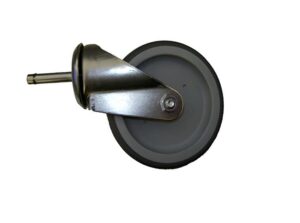When it comes to selecting the right casters for your equipment or furniture, you're faced with a critical decision: rubber casters or polyurethane casters? Both offer unique advantages and are designed for specific applications. In this guide, we'll break down the differences between these two caster types to help you make an informed choice that suits your needs.

1. Material Matters
Let's start with the basics: the materials. Rubber casters, as the name suggests, are made from rubber. They are known for their excellent shock absorption properties, which make them ideal for applications where reducing vibrations is crucial. On the other hand, polyurethane casters are crafted from a type of plastic known as polyurethane. This material is prized for its durability and resistance to wear and tear.
2. Floor Protection
Rubber casters are often chosen when floor protection is a top priority. The soft rubber material is non-marking, which means it won't leave scuffs or marks on delicate flooring surfaces like hardwood or tile. So, if you have valuable flooring to preserve, rubber casters are your go-to solution.
Polyurethane casters, while durable, may not offer the same level of floor protection as rubber. They could potentially leave marks on sensitive surfaces, so keep this in mind when making your selection.
3. Load Capacity
Another essential factor to consider is load capacity. Rubber casters are suitable for light to medium-duty applications. They excel in situations where you need smooth and quiet movement, such as office chairs and light-duty carts.
Polyurethane casters, on the other hand, are built to handle heavier loads. Their robust construction allows them to withstand the weight of heavy equipment, making them a reliable choice for industrial and manufacturing settings.
4. Maneuverability
When it comes to maneuverability, rubber casters shine in terms of ease of rolling and turning. They provide smooth and effortless movement, making them suitable for applications where you need to navigate tight spaces or corners.
Polyurethane casters also offer good maneuverability, but they might not be as agile as rubber casters in some scenarios. It's essential to assess your specific needs to determine which type of caster will provide the desired level of maneuverability.
5. Noise Levels
Noise can be a significant concern, especially in quiet environments like offices or hospitals. Rubber casters are known for their quiet operation. They produce minimal noise when rolling, contributing to a peaceful work or healthcare environment.
Polyurethane casters, while not excessively noisy, may generate slightly more sound during movement. If noise reduction is crucial for your application, rubber casters are the quieter option.
6. Cost Considerations
Finally, let's talk about cost. Rubber casters are often more budget-friendly than their polyurethane counterparts. If you're looking for a cost-effective solution for light to medium-duty applications, rubber casters can save you money without compromising on quality.
Polyurethane casters, being more durable and suitable for heavy-duty use, may come with a higher price tag. However, they offer excellent long-term value due to their extended lifespan and load-bearing capacity.
Conclusion
In the battle of rubber casters vs. polyurethane casters, there's no one-size-fits-all answer. Your choice should align with your specific needs and priorities. If you value floor protection, noise reduction, and smooth-rolling, rubber casters are a solid choice. On the other hand, if you require high load capacity and durability for heavy-duty applications, polyurethane casters are the ultimate wheel warriors.
Ultimately, the decision between rubber casters and polyurethane casters depends on your unique requirements and budget considerations. Assess your needs carefully, and you'll be able to choose the right caster type to keep your equipment or furniture rolling smoothly.
Learn more about Julong Rubber and our rubber wheels solutions here.








